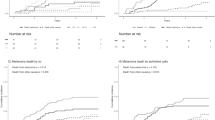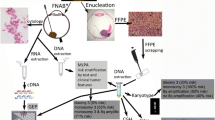Abstract
Background
Monosomy 3 is a highly specific marker for poor prognosis in posterior uveal melanoma. Unfortunately, cytogenetic prognostication is limited to enucleated eyes or resected tumors. The aim of this study was to evaluate mid-term natural history and safety of in vivo detection of chromosome 3 status in posterior uveal melanomas undergoing plaque brachytherapy.
Methods
A 25-gauge transscleral fine needle aspiration biopsy (FNAB) was performed in 32 eyes affected by posterior uveal melanoma undergoing plaque brachytherapy, just before applying the radioactive plaque. Sampled material underwent fluorescence in situ hybridization (FISH) with centromeric probes for chromosome 3. All patients had a follow-up of at least 36 months.
Results
Mean follow-up was 47.1 ± 8.5 months. Mean largest basal diameter and mean thickness of the tumors were 12.5 ± 2.7 mm and 8 ± 2.3 mm respectively. FNAB yielded sufficient material in 26 of 32 cases (81.2%). Adequacy of the sample ranged from 91.1% (ciliary body tumors) to 76.8% (choroidal tumors). Seventeen cases had monosomy 3 (65.3%). No correlation was found between monosomy 3 and tumor dimensions or location (ciliary body vs choroidal tumors). No early and mid-term local complications were documented. Seven patients (21.8%) died during follow-up: five (15.6%) of them died due to metastatic disease (all had monosomy 3 tumors).
Conclusions
Posterior uveal melanomas may be adequately and safely sampled, by intra-operative transscleral FNAB, to detect in vivo monosomy 3.
Similar content being viewed by others
References
Seregard S (1996) Posterior uveal melanoma. Acta Ophthalmol Scand 74:315–329
Naus NC, Verhoeven ACA, van Drunen E, Slater R, Mooy CM, Paridaens DA, Luyten GP, de Klein A (2002) Detection of genetic prognostic markers in uveal melanoma biopsy using fluorescence in situ hybridization. Clin Cancer Res 8:534–539
Gamel JW, McLean IW, McCurdy JB (1993) Biologic distinctions between cure and time to death in 2892 patients with intraocular melanoma. Cancer 119:786–791
Kujala E, Kivela T (2005) Tumor, node, metastasis classification of malignant ciliary body and choroidal melanoma evaluation of the 6th edition and future directions. Ophthalmology 112:1135–1144
Schmittel A, Bechrakis NE, Martus P, Mutlu D, Sheibenbogen C, Bornfeld N, Foerster MH, Thiel E, Keilholz U (2004) Independent prognostic factors for distant metastases and survival in patients with primary uveal melanoma. Eur J Cancer 40:2389–2395
Gambrelle J, Labialle S, Dayan G, Gayet L, Barakat S, Grange JD, Baggetto LG (2004) Toward monosomy 3 as the main prognosis factor of uveal melanoma: current cytogenetic data. J Fr Ophtalmol 27:1061–1067
Kilic E, Naus NC, van Gils W, Claver CC, van Til ME, Verbiest MM, Stijnen T, Mooy CM, Paridaens D, Beverloo HB, Luyten GP, de Klein A (2005) Concurrent loss of chromosome arm 1p and chromosome 3 predicts a decreased disease-free survival in uveal melanoma patients. Invest Ophthalmol Vis Sci 46:2253–2257
Scholes AGM, Damato BE, Nunn J, Hiscott P, Grierson I, Field JK (2003) Monosomy 3 in uveal melanoma: correlation with clinical and histologic predictors of survival. Invest Ophthalmol Vis Sci 44:1008–1011
Höglund M, Gisselsson D, Hansen GB, White VA, Sall T, Mitelman F, Horsman D (2004) Dissecting karyotypic patterns in malignant melanomas: Temporal clustering of losses and gains in melanoma karyotypic evolution. Int J Cancer 108:57–65
Sisley K, Rennie IG, Cottam DW, Potter AM, Potter CW, Rees RC (1990) Cytogenetic findings in six posterior uveal melanomas: involvement of chromosomes 3, 6 and 8. Genes Chromosomes Cancer 2:205–209
Sandinha M, Farquharson M, Mckay I, Roberts F (2005) Monosomy 3 predicts death but not time to death in choroidal melanoma. Invest Ophthalmol Vis Sci 46:1497–1501
Onken M, Worley L, Ehlers J, Arbour JW (2004) Genes expression profiling reveals two molecular classes and predict metastatic death. Cancer Res 64:7205–7209
Prescher G, Bornfeld N, Becher R (1990) Non-random chromosomal abnormalities in primary uveal melanoma. J Natl Cancer Inst 82:1765–1769
Sisley K, Cottam DW, Rennie IG, Parson MA, Potter AM, Potter CW, Rees RC (1992) Non-random abnormalities of chromosomes 3, 6, and 8 associated with posterior uveal melanoma. Genes Chromosomes Cancer 5:197–200
Sisley K, Tattersall N, Dyson M, Smith K, Mudhar H, Rennie I (2006) Multiplex fluorescence in situ hybridization identifies novel rearrangements of chromosome 6, 15, and 18 in primary uveal melanoma. Exp Eye Res 83:554–559
Tschentscher F, Hüsing J, Hölter T, Kruse E, Dresen IG, Jockel KH, Anastassiou G, Schilling H, Bornfeld N, Horsthemke B, Lohmann DR, Zeschnigk M (2003) Tumor classification based on gene expression profiling shows that uveal melanomas with and without monosomy 3 represent two distinct entities. Cancer Res 63:2578–2584
Sisley K, Nichols C, Parsons MA, Farr R, Rees RC, Rennie IG (1998) Clinical applications of chromosome analysis, from fine needle aspiration biopsies, of posterior uveal melanomas. Eye 12:203–207
Midena E, Bonaldi L, Parrozzani R, Tebaldi E, Boccassini B, Vujosevic S (2006) In vivo detection of monosomy 3 in eyes with medium-sized uveal melanoma using transscleral fine needle aspiration biopsy. Euro J Ophthalmol 16:422–425
Prescher G, Bornfeld N, Hirche H, Horsthemke B, Jockel KH, Becher R (1996) Prognostic implications of monosomy 3 in uveal melanoma. Lancet 347:1222–1225
Kvanta A, Seregard S, Kopp ED, All-Ericsson C, Landau I, Berglin L (2005) Choroidal Biopsies for intraocular tumors of indeterminate origin. Am J Ophthalmology 140:1002–1006
Shields JA, Shields CL, Ehya H, Eagle RCJ, De Potter P (1993) Fine-needle aspiration biopsy of suspected intraocular tumors. The 1992 Urwick Lecture. Ophthalmology 100:1677–1684
Caminal JM, Sanz S, Carreras M, Català I, Arruga J, Rocca G (2006) Epibulbar seeding at the site of a transvitreal fine-needle aspiration biopsy. Arch Ophthalmology 124:587–589
Shields CL, Ganguly A, Materin MA, Teixeira L, Mashayekhi A, Swanson LA, Marr BP, Shields JA (2007) Chromosome 3 analysis of uveal melanoma using fine-needle aspiration biopsy at the time of plaque radiotherapy in 140 consecutive cases. Arch Ophthalmol 125:1017–1024
Sen J, Groenewald C, Hiscott P, Smith P, Damato B (2006) Transretinal choroidal tumor biopsy with a 25-gauge vitrector. Ophthalmology 113:1028–1031
Sandinha T, Farquharson M, McKay I, Roberts F (2006) Correlation of Hetergeneity for chromosome 3 copy number with cell type in choroidal melanoma of Mixed-cell type. Invest Ophthalmol Vis Sci 47:5177–5180
Maat W, Jordanova ES, van Zelderen-Bhola SL, Barthen ER, Wessels HW, Schalij-Delfos NE, Jager MJ (2007) The heterogeneous distribution of monosomy 3 in uveal melanomas: implications for prognostication based on fine-needle aspiration biopsies. Arch Pathol Lab Med 131:91–96
Meir T, Zeschnigk M, Masshofer L, Pe’er J, Chowers I (2007) The spatial distribution of monosomy 3 and network vasculogenic mimicry patterns in uveal melanoma. Invest Ophthalmol Vis Sci 48:1918–1922
Onken MD, Worley LA, Parson E, Char HD, Bowcock AM, Harbour JW (2007) Prognostic testing in uveal melanoma by trancriptomic profiling of fine needle biopsy specimens. Clin Cancer Res 13:2923–2927
Worley LA, Onken MD, Parson E, Robirds D, Branson J, Char DH, Perry A, Harbour JW (2007) Transcriptomic versus chromosomal prognostic markers and clinical outcome in uveal melanoma. Clin Canc Res 13:1466–1471
Sisley K, Rennie IG, Parsons MA, Jacques R, Hammond DW, Bell SM, Potter AM, Rees RC (1997) Abnormalities of chromosomes 3 and 8, in posterior uveal melanoma, correlate with prognosis. Genes Chromosom Cancer 19:22–28
Collaborative Ocular Melanoma Study Group (2001) Report No. 26. Development of metastatic disease after enrollment in the COMS trials for treatment of choroidal melanoma. Arch Ophthalmol 119:961–965
Aalto Y, Eriksson L, Seregard S, Larsson O, Knuutila S (2001) Concomitant loss of chromosome 3 and whole arm losses and gains of chromosome 1, 6, or 8 in metastasizing primary uveal melanoma. Invest Ophthalmol Vis Sci 42:313–317
Hughes S, Damato BE, Giddings I, Hiscott PS, Humphreys J, Houlston RS (2005) Microarray comparative genomic hybridisation analysis of intraocular uveal melanomas identifies distinctive imbalances associated with loss of chromosome 3. Br J Cancer 93:1191–1196
Tschentscher F, Prescher G, Zeschnigk M, Horsthemke B, Lohmann DT (2000) Identification of chromosome 3, 6, and 8 aberrations in uveal melanoma by microsatellite analysis in comparison to comparative genomic hybridization. Cancer Genet Cytogenet 122:13–17
Worley LA, Onken MD, Person E, Robirds D, Branson J, Char DH, Perry A, Harbour JW (2007) Transcriptomic versus chromosomal prognostic markers and clinical outcome in uveal melanoma. Clin Cancer Res 13:1466–1471
Onken MD, Worley LA, Person E, Char DH, Bowcock AM, Harbour JW (2007) Loss of Heterozygosity of chromosome 3 detected with single nucleotide polymorphisms is superior to monosomy 3 for predicting metastasis in uveal melanoma. Clin Cancer Res 13:2923–2927
Author information
Authors and Affiliations
Corresponding author
Additional information
The authors have no financial interest in the subject of this paper.
The authors have full control of all primary data and they agree to allow Graefe’s Archive for Clinical and Experimental Ophthalmology to review their data if requested.
Rights and permissions
About this article
Cite this article
Midena, E., Bonaldi, L., Parrozzani, R. et al. In vivo monosomy 3 detection of posterior uveal melanoma: 3-year follow-up. Graefes Arch Clin Exp Ophthalmol 246, 609–614 (2008). https://doi.org/10.1007/s00417-007-0692-4
Received:
Revised:
Accepted:
Published:
Issue Date:
DOI: https://doi.org/10.1007/s00417-007-0692-4




